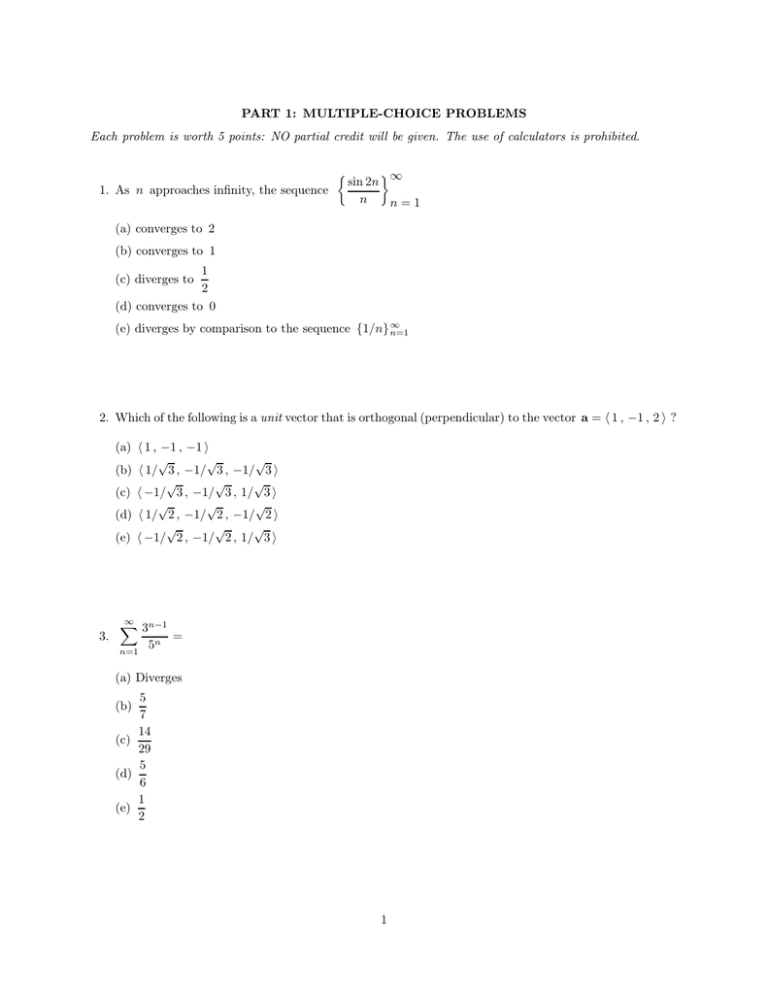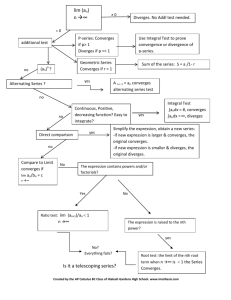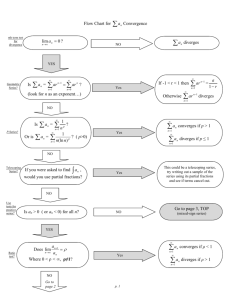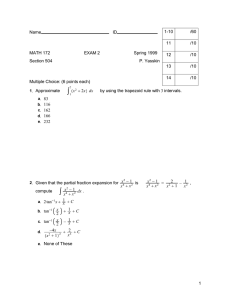PART 1: MULTIPLE-CHOICE PROBLEMS
advertisement

PART 1: MULTIPLE-CHOICE PROBLEMS
Each problem is worth 5 points: NO partial credit will be given. The use of calculators is prohibited.
1. As n approaches infinity, the sequence
∞
sin 2n
n
n=1
(a) converges to 2
(b) converges to 1
1
2
(d) converges to 0
(c) diverges to
(e) diverges by comparison to the sequence {1/n} ∞
n=1
2. Which of the following is a unit vector that is orthogonal (perpendicular) to the vector a = h 1 , −1 , 2 i ?
(a) h 1 , −1 , −1 i
√
√
√
(b) h 1/ 3 , −1/ 3 , −1/ 3 i
√
√
√
(c) h −1/ 3 , −1/ 3 , 1/ 3 i
√
√
√
(d) h 1/ 2 , −1/ 2 , −1/ 2 i
√
√
√
(e) h −1/ 2 , −1/ 2 , 1/ 3 i
3.
∞
X
3n−1
=
5n
n=1
(a) Diverges
5
7
14
(c)
29
5
(d)
6
1
(e)
2
(b)
1
4. The third-degree Taylor polynomial for f (x) = ln x at a = 1 is
1
1
(a) (x − 1) − (x − 1)2 + (x − 1)3
2
3
1
2
(b) (x − 1) − (x − 1)2 + (x − 1)3
2
3
2
(c) (x − 1) − (x − 1) + 2(x − 1)3
x − 1 (x − 1)2
(x − 1)3
−
+
x
2x2
2x3
(x − 1)3
x − 1 (x − 1)2
−
+
(e) ln x +
x
2x2
3x3
(d) ln x +
5. If the nth partial sum of the series
∞
X
an is sn =
n=1
(a) 0
2
3
(c) Diverges
(b)
3
2
(e) 1
(d)
6.
∞
X
n=1
1
=
(n + 2)(n + 3)
1
3
1
(b)
4
(c) 0
(a)
1
2
(e) Diverges
(d)
2
2n2 + 2
, then
3n2 + 1
∞
X
n=1
an =
7. The infinite series
∞
X
n=1
n
3
n +5
(a) Converges by the nth term divergence test.
(b) Diverges by the comparison test.
(c) Converges by the comparison test.
(d) Diverges by the ratio test.
(e) Converges by the ratio test.
8. The center of the sphere x2 + y 2 + z 2 + 6x − 8y = 0 is located at
(a) (0 , 0 , 0)
(b) (3 , −4 , 0)
(c) (3 , 4 , 0)
(d) (−3 , 4 , 0)
(e) (3 , 0 , 4)
3
9. Which of the following series converges?
(a)
(b)
(c)
(d)
∞
X
√
(−1)n n
n=2
∞
X
n=2
∞
X
n=1
∞
X
n3
n4 + 5
n!
(n2002 )
1
n(ln n)2
n=2
−n
∞ X
1
(e)
1−
n
n=1
10. Which of the following series is absolutely convergent?
(a)
∞
X
(−1)n
n=2
1
n ln n
∞
X
(b)
1
(−1)n √
n
n=1
(c)
∞
X
(−1)n
n0.998
n=1
(d)
∞
X
1
n
n=1
(e)
∞
X
1
1.001
n
n=1
4
PART 2: WORK-OUT PROBLEMS
The use of calculators is prohibited. SHOW ALL WORK!
11. Find the radius of convergence and the exact interval of convergence of the power series
Clearly justify your answer!
∞
X
(−1)n (x − 3)n
.
n(2n )
n=1
(10 points)
5
12. Apply a test to determine if each of the following series converges or diverges. You must name the test,
clearly explain why the test applies and clearly justify your conclusion.
(a) (5 points)
∞
X
n=1
(b) (5 points)
∞
X
n=1
1
√
n+1
(−1)n
n
n+1
6
Circle one : Converges
Diverges
Circle one : Converges
Diverges
13. (a) (5 points) Start from a known series to find a power series about a = 0 for f (x) =
radius of convergence.
(b) (5 points) Use your answer above to find a power series about a = 0 for
of convergence.
7
1
and its
4 + x2
2x
and its radius
(4 + x2 )2
14. (a) (8 points) Use the Maclaurin series for sin(t 2 ) to find the Maclaurin series for
Z
x
0
Z
(b) (7 points) Use the first 2 terms of the series above to estimate
error. Do not simplify. Justify the error estimate.
8
0
0.1
sin(t2 ) dt .
sin(t2 ) dt and estimate the
∞
X
[1 − cos(1/n)] converges or diverges. Clearly justify your answer!
n=1
HINT: What is the Maclaurin series for cos x ?
15. (5 points) Determine if
9



